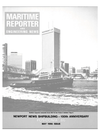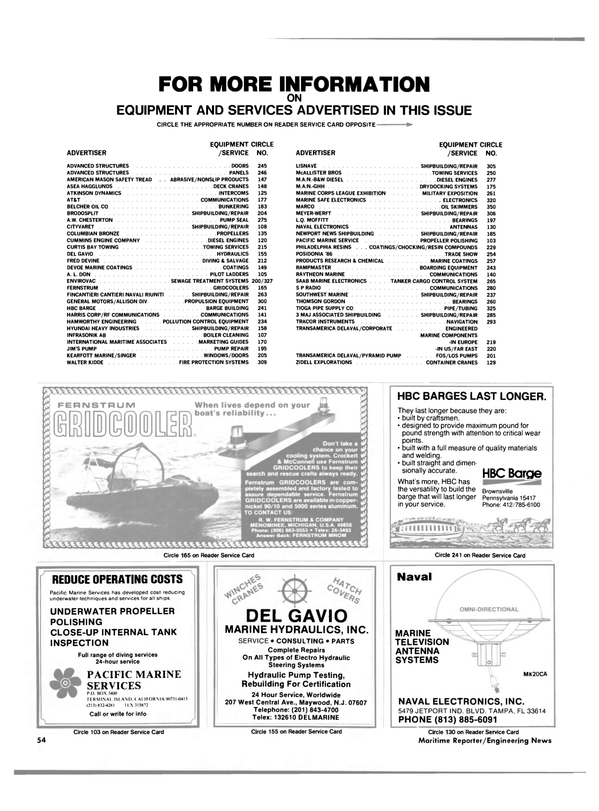
Sail Freight International Offers Design For Auxiliary Wind Propulsion
According to Capt. D.C. (Sandy Anderson, founder of Sail Freight International (SFI) of Greenwich, Conn., sail-assist should be viewed as a total performance improvement package and not solely as a fuel-conservation measure. In this light, sailassist undoubtedly has a future in the modern merchant marine.
The Japanese clearly have the lead in this area, with a total of 20 ships either trading or in various stages of completion. The size of these ships ranges from about 1,000 dwt with 93 square meters of sail area, all the way up to 50,000 dwt and 14,000 square meters of sail.
There are four principal methods of using wind power at sea. With the exception of the soft sail approach that SFI is presently using, all other sail-assist techniques use one of the high-technology, high capital cost systems that, without exception, are best suited for installation as part of the ship's original construction.
Even then the pay-back in oil savings will be in excess of 10 years at current oil prices. The pay-back for the soft sail system will generally be less than two years and sometimes less than one. SFI is said to be the only company in the world today offering a complete "turnkey" package of low-cost sail-assist for shipowners and operators seeking to retrofit some form of sail-assist into their existing vessels.
SFI provided the technology, Colonial Navigation Inc. of Savannah, Ga., supplied the ship, and several manufacturers provided equipment at reduced costs. The results of this effort have helped to launch a new technology for marine transportation in the U.S.
In the complete service offered by SFI, the first step is analysis. Sailassist does not work on all vessels under all circumstances, and many variables must be looked at before any system should be considered.
A potential user of sail-assist will look first at the installed cost, then ease of operation; the system's lift coefficient will generally be third.
SFI uses a sophisticated computer model to analyze these variables. In this way, the vessel can be "operated" in the computer model both with and without sails. The results of this simulation offer a good preliminary indication as to whether sail-assist should be investigated further.
The installed cost of SFI's Pro- Tech I system of sail-assist ranges from about $320 per square meter to about $600 per square meter, depending on the vessel's existing equipment. The "fuel" to operate the sails is free for the life of the system. This fact must be tempered, however, with the understanding that sail-assist works only when the wind is blowing. The cost/benefit comparison is further complicated when it is considered that fuel savings are third in line when it comes to quantifying the advantages of sail-assist to the shipowner. The first and second items on this list, increased speed and decreased engine wear, are difficult to quantify accurately but they are nevertheless the most important in today's market.
SFI installed the ProTech I system of sail-assist on Colonial Navigation's 3,000-dwt bulk carrier Carib Alba (photo) in 1985. The entire installation took only 10 days, as most of the equipment had been prefabricated. The ship has operated steadily since then with no major mishaps or delays. The horsepower generated by the sails can be used in either of two ways. When energy conservation is important, the ship is able to reduce rpm slightly and maintain the original speed while reducing oil consumption up to 35 percent. During this time, stack temperatures drop as the engine is under far less load. If time is more important then energy conservation, the ship is able to increase speed by up to 15 percent while fuel consumption remains the same or decreases slightly. To do this, the sails are set but the engine is left at full rpm. The ship is then going faster while burning slightly less fuel, and the engines are not working quite so hard.
SFI has learned from this experience that it is important to work closely with the operating staff of the shipowner in order for the shipping company to realize the full benefits of sail-assist. This is the main reason SFI has become affiliated with a major shipowner/operator in Greenwich, Conn.—Skaarup Ship Management. Working with that company, Sail Freight International can now offer all phases of sail-assist to the neophyte user: analysis, design, installation, and operation For further information on SFI, Circle 10 on Reader Service Card
Read Sail Freight International Offers Design For Auxiliary Wind Propulsion in Pdf, Flash or Html5 edition of May 1986 Maritime Reporter
Other stories from May 1986 issue
Content
- Texaco Signs Globtik Ship Management Contract page: 5
- National AirOil Introduces Portable Burner Ignitor page: 5
- Hitachi Zosen Delivers High-Speed Containership To Highness Maritime page: 6
- Moss Point Marine Lays Keel For First Of Two Navy Landing Craft page: 6
- Haggett Chairman Of Shipbuilders Council— Schaefer Is Vice Chairman page: 7
- SNAME SPRING MEETING/ STAR SYMPOSIUM page: 8
- Hyundai Launches Advanced Aker Semisubmersible Drilling Rig page: 11
- Radio-Holland To Distribute Anschuetz Products In U . S. page: 14
- John Crane Schedules 'Mechanical Maintenance S k i l l s ' Seminar Programs page: 15
- Bailey Supplies Control System For World's Largest Submersible Derrick Barge page: 16
- PSMA Elects Board Of Directors For 1986 page: 18
- Moran Towing Appoints Kenneth S. Johnson Chief Harbor Dispatcher page: 18
- Taylor Diving Receives Contracts From Shell, Mobil page: 19
- 2-Volume Research Report Now Available On Fuel Efficient Vessel Operations page: 19
- Grandi Motori To Unveil Diesel Engine Designs page: 20
- Bailey Offers Technical Paper On Better Combustion Control page: 20
- Navy Acquisition Streamlining Topic At Hampton Roads SNAME page: 22
- Adams & Porter Elects Three New Executives page: 22
- IMA To Publish Report On Navy Ship Systems Market page: 22
- Racal Marine Moves To New Headquarters In Cranford, N.J. page: 23
- New McAllister Tractor Tug Inaugurates Jacksonville Service page: 24
- Alaska Barge Lines Begins New Service page: 26
- Coast Guard Admiral Urges More Input From The Marine Community page: 26
- Imperial Receives Order For 500 Survival Suits page: 27
- Todd Chairman To Retire In July; Board Nominates New Chairman And President page: 28
- Free Literature Offered On New NABRICO Hand Winch page: 28
- NEWPORT NEWS MARKS 100 YEARS OF SHIPBUILDING LEADERSHIP page: 29
- CDI Offshore Appoints Payne And Domingue To Management Positions page: 37
- BFGoodrich Offers Brochure On Cutless Line Of Rubber Bearings page: 37
- POSIDONIA '86 INTERNATIONAL SHIPPING EXHIBITION page: 38
- S h i p b u i l d i n g And Ocean Engineering Conference In H e l s i n k i — S e p t . 7 - 10 page: 41
- Bardex Receives Contract For Rig Skidding S y s t em F r om Shell U . K. page: 41
- Centrico Manufactures High-Tech Centrifuges page: 41
- A Report On The Yugoslav Shipbuilding Industry page: 42
- Unique Slipway Launch Of Aft Part Of Hull Performed At 3.Maj Yard page: 42
- 2-Volume Research Report, 'Ship Performance Analysis System' Now Available page: 43
- Baker Named President Of WATERCOM page: 44
- Sperry To Market Puroflow Power-Line Filters page: 45
- New Racal Survey And Dredge Control System page: 48
- GALAX Offers New Free Literature On Kit-Assembled Marine Control Consoles page: 48
- Russellstoll Engineers Gain Patent For Fluorescent Lamp-Locking Device page: 49
- Cummins-Powered Empress Launched By Serodino, Inc. page: 49
- Hardware Specialty Offers Complete Shipbuilding Fastener And Hardware Line page: 52
- Full-Color Brochure On 150-Ton Mobile Boat Hoist From Marine Travelift page: 52
- Sail Freight International Offers Design For Auxiliary Wind Propulsion page: 52
- New Simulator Training Complex For U.S. Navy page: 53
- CCA Holds Meeting, Appoints Officers page: 53
- Omnithrusters installed In Variety Of Canadian Government Vessel Types page: 59
- Valmet Opens New Engineering Office In Calgary, Canada page: 59
- Woodward Offers Brochures On Turbine Modernization And Cogeneration Process page: 59
- EG&G Receives New 3-Year Navy Contract For Program Support page: 59
- NABRICO Constructs 2 Dump Scows For Panama Canal Commission page: 63
- Tri-Tex Introduces New Video Medcare First Responder® System page: 63
- J.J. Henry Announces Key Executive Appointments page: 63


